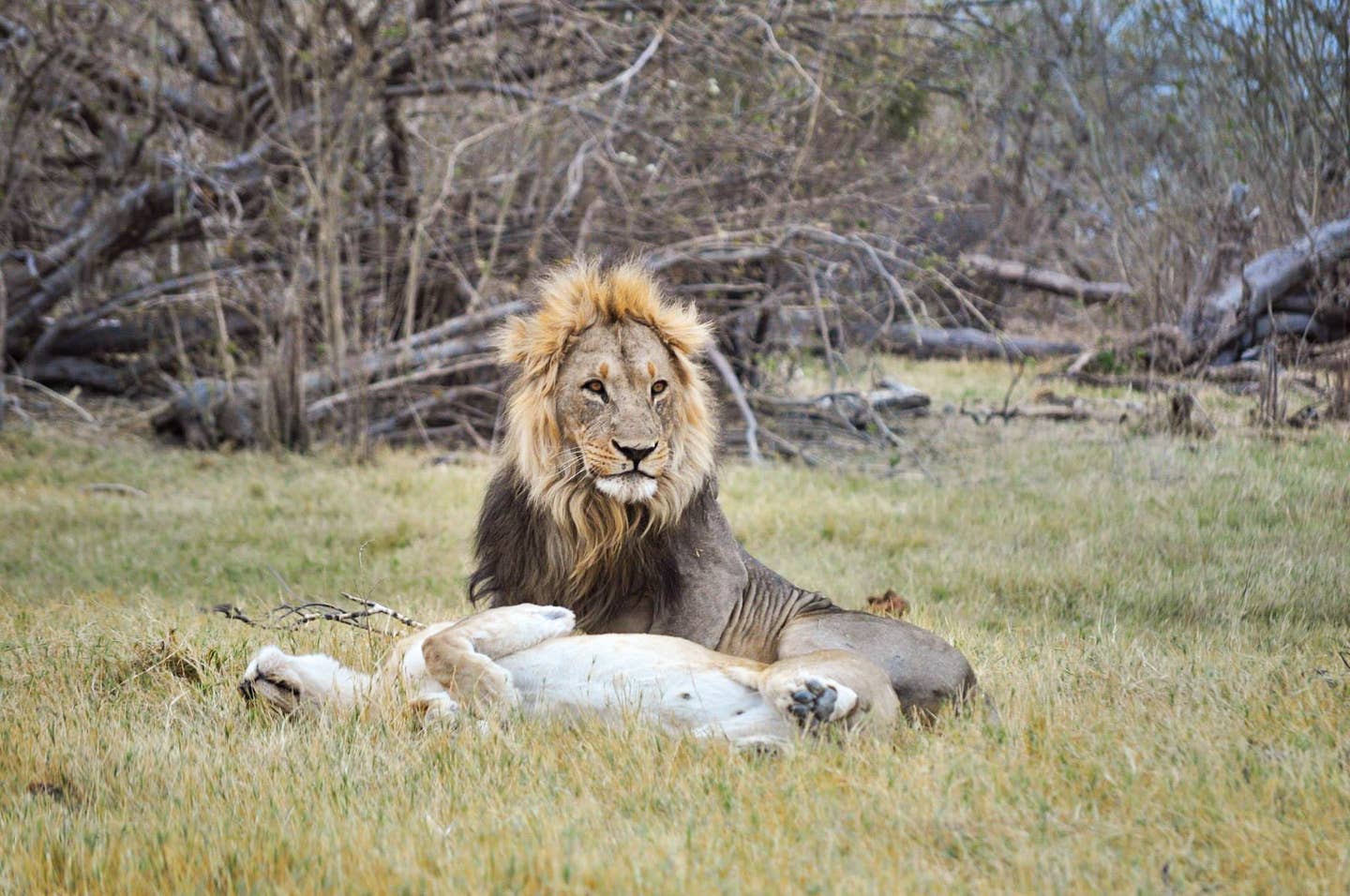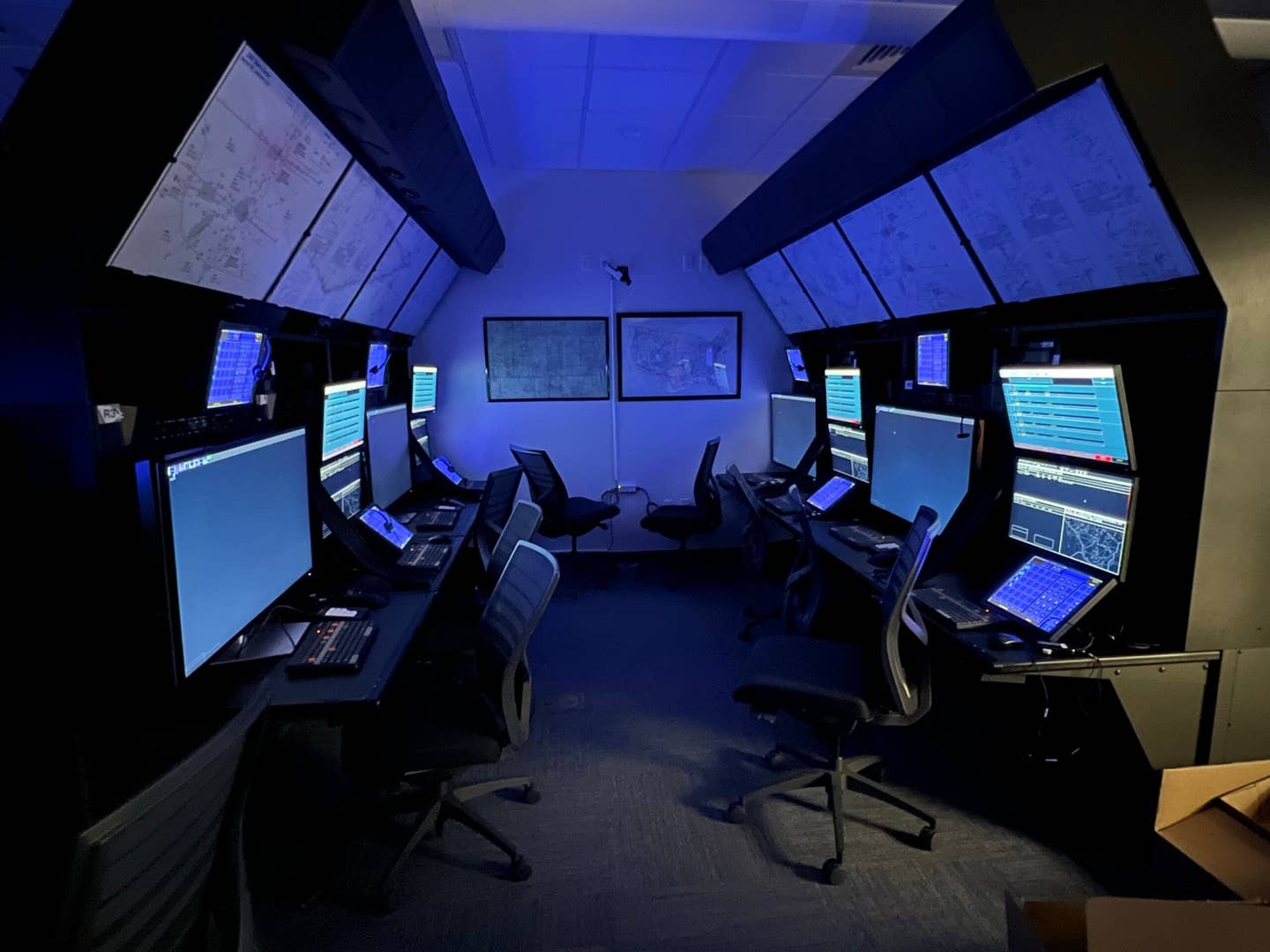
The “King of Beasts” provided some memorable moments on our African adventure. Courtesy Sam Weigel
It was a blindingly bright afternoon on the edge of the Okavango Delta—warm and sunny on this July winter day. Our Land Rover Defender chugged along the dirt track that paralleled and crisscrossed a reedy canal, occasionally turning muddled and confused among a profusion of game trails trampled through the ocher sea of grass by ever-present herds of impala, lechwe, sable, kudu, and the massive 6-ton African elephants that eyed our Landy like a smaller interloper that might potentially need to be run off. Our attention, however, was focused on the tree line to our left. We stopped every few minutes, and my eagle-eyed wife Dawn scanned the bush with her binoculars.
Twenty minutes before, we’d passed a Toyota 4Runner coming the opposite direction, carrying a South African father and son who told us they’d spotted an elusive cheetah stalking along this tree line. We’d seen most of the other notable species of African wildlife over the past two weeks but desperately wanted to see a cheetah. As I turned onto a side trail that meandered toward the tree line, I heard a familiar drone over the rhythmic thump of the Land Rover’s diesel engine. It was a Mack Air Cessna 206, scribing an arc a thousand feet overhead. We were east of the bush camps, so they were likely on a sightseeing tour. Had they spotted the big cat for which we were searching? I thought back to three days earlier, when we’d flown over this very area in another Mack Air 206.
I’ve been blessed with a fairly stable aviation career despite starting it during one of the most tumultuous periods in a chronically unstable industry. I made a few lateral moves but always of my own volition, was never furloughed, and made steady, if stately, progress down the well-worn flight-instructing to freight-dogging to regional-airline to major-airline paths. But along the way, I always kept a few practical Plan B backups in my pocket—plus a couple fantasy options in case things really went to hell in a handbasket. One of these long-standing fantasies, partially fueled by a monster thread on the Professional Pilots Rumour Network website, was to hitch a ride to Maun, Botswana, and land a job flying piston singles into the African bush.
This is actually a viable option for time building among adventurous young European and South African pilots, but few American pilots find their way to Maun. To me, whose only experience on the continent at the time was a short visit to Cairo, it seemed like a terribly romantic idea. Sub-Saharan Africa existed in my mind as an abstraction—a cartoon, really—a dual image imprinted by National Geographic and the nightly news: on one hand, a primeval paradise unsullied by the touch of man and, on the other, a dark continent filled with poverty, conflict and dysfunction. My curiosity woefully lacking, I had no plans and no great desire to go see the place for myself.
But then Dawn, fresh off a self-imposed travel ban while she crammed to finish her two-year master’s degree program in 18 months, requested that we travel to southern Africa as an “attagirl” reward and our 10th-wedding-anniversary trip. So, we flew into Cape Town, visited the Cape Winelands, drove the “Garden Route” along the Indian Ocean to Durban, took a train to Johannesburg, and rented a Land Rover TD 110 kitted out with rooftop tent, safari snorkel, and full self-recovery and camping equipment. The next five days were spent in Kruger National Park, which abounds in wildlife but whose paved roads and comfortable, protected camps made the rugged Land Rover entirely superfluous.
We found South Africa to be a fascinating place, with gorgeous and diverse geography, excellent (and cheap) food and wine, many interesting things to do, well-developed tourism infrastructure, and most people very friendly to outsiders—but also with a great deal of stark poverty (often situated cheek-by-jowl with Western-style affluence), open racial animus and constant vigilance required for personal security.
As soon as we went into Botswana, it was apparent that it’s a very different country from its larger southern neighbor. Botswana is mostly flat and rather stark, being largely covered by the Kalahari Desert. It is sparsely populated, with one small city and a few medium-size towns, and relatively affluent thanks to its mineral wealth (happily discovered post-independence). Unlike neighboring countries, it was never really colonized, never experienced apartheid and was never scarred by civil war.
Early on, Botswana’s leaders recognized what a potentially valuable draw they had in the Okavango Delta and its teeming wildlife, and they made two smart decisions. First, they set up two wildlife preserves totaling 6,500 square miles (or nearly twice the size of Yellowstone National Park) in the northwest corner of the country: Chobe National Park and Moremi Game Reserve. Next, they decided to leave the preserves largely undeveloped, eschewing mass tourism in favor of attracting a smaller number of well-heeled tourists with high-end safaris and isolated game lodges. It resulted in less impact on the wildlife and greater income for guides and outfitters—and more business for charter airlines like Mack Air, which hauls supplies and clients to many of the water-bound lodges and camps.
Fortunately for cheap airline pilots and adventurous types, there are also 35 individual public campsites scattered through Moremi and Chobe that are available to independent travelers who have their own capable off-road vehicle and are otherwise self-sufficient. These are popular with South African off-roaders and are typically booked six months to a year in advance. The campsites are completely open to wildlife; rooftop tents are de rigueur, and after dark, it’s advised to stay in them. Trails are unmaintained and unmarked, and most rivers must be forded and are occasionally impassable.
It sounded like a fantastic adventure, so I planned an eight-day, 250-kilometer self-guided itinerary starting in Maun and ending at the northern outpost of Kasane. While in Maun, I figured I’d indulge my African bush-pilot fantasy a bit while getting a bird’s-eye view of the wilderness we’d be traversing.
Read More from Sam Weigel: Taking Wing
It’s a long and mostly desolate drive from the South African border to Maun, and we arrived late in the afternoon. The town was a lot larger (55,000 people) and more modern than I imagined, though it retained a certain dusty frontier feel. Scenic campgrounds straddle both sides of the slow-moving Thamalakane River along the dirt road out of town to Moremi’s south gate.
The airport is surprisingly large—the runway is more than 12,000 feet long—and the expansive ramp is ringed by several large hangars and covered with various piston and turboprop singles, as well as twins of assorted national registry. At Mack Air headquarters, they quickly agreed to charter us a Cessna 206 and pilot the following day at a rather reasonable rate.
The next day, we showed up at the airport and were introduced to Ryan, a young pilot from South Africa. This was his second tourist season flying out of Maun, and he said he was planning to stay over the summer low season this year. Lifting off and banking toward the northwest, it became immediately apparent why the Okavango Delta attracts so much wildlife: The surrounding area is parched in the dry season, burnt orange to the horizon, while the Delta blooms despite receiving a similar 18 inches of rain per year. It’s the Angolan highlands far to the north that receive torrential rainfall during the summer storms; the floodwaters flow to the southeast and enter a basin with no outlet. It takes a full month for the flood to travel the length of the Okavango River and then another several months to percolate through the myriad channels and reedy swamplands of the delta, forming a valuable water source just as the surrounding desert reaches its driest period.
The result is spectacular to see from the air: a profusely colorful patchwork of water, reeds, lily pads and grassy islands; a wild maze of game trails; and enormous, teeming herds of glossy, black buffalo, ruddy lechwe, sleek impala, galloping zebras and lumbering elephants. Here, a hippo splashes about a muddy pool, and there, the deadly ridge of a patient Nile crocodile’s back barely breaks the surface—and, farther on, a muscular lioness creeps through tall grass toward a band of unsuspecting kudu. A dusty landing strip passed under our wings, along with a fenced compound of wooden huts perched on the edge of a watering hole. About the only thing I didn’t see during our hourlong flight was a cheetah.
Three days later, night was falling on the edge of the Okavango Delta. We never did find that cheetah, but we had an exciting moment when the trail through the tree line rounded a bend and we came face to face with a massive bull elephant who seemed to give serious thought to charging us. Then, we were sitting around a crackling fire with the German couple with whom we were sharing our campsite; they had driven their Toyota HiLux 4x4 from Namibia. A pair of eyes glowed from a nearby bush. I threw a stone, and the hyena scampered off. A few minutes later, a quite large hippopotamus awkwardly lumbered from the reeds with a great crash, causing us to scamper for the safety of our respective vehicles. Shortly thereafter, we retreated to our rooftop tents for the night.
I woke at 4 a.m. to a soft padding noise and then a rather feline growl. I didn’t sleep a wink after that, the alarm for our morning game drive going off an hour later—which is when we discovered sizable lion paw prints directly below our tent. It was a bit of a hair-raising moment but a really neat experience too. Over the next few days, we had dozens of interesting experiences like that within our self-guided African adventure, and it occurred to me that I might have never thought to come here if I hadn’t read that PPRuNe thread about time building in Maun. It’s pretty remarkable, actually, just how many times in my life aviation has informed and enriched the adventures that I’ve been fortunate to share with friends and loved ones around our amazing world.
This story appeared in the May 2020 issue of Flying Magazine

Sign-up for newsletters & special offers!
Get the latest FLYING stories & special offers delivered directly to your inbox






